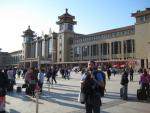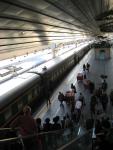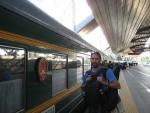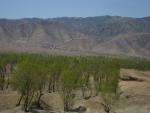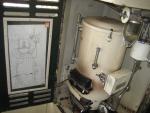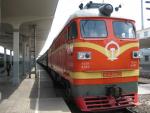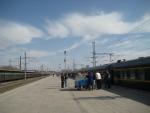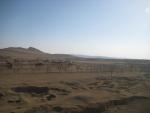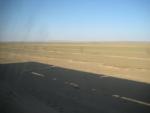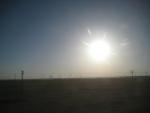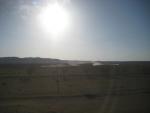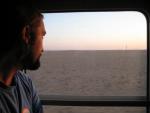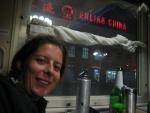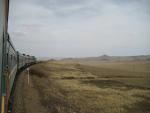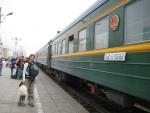The first leg of our journey home: Beijing - UlaanBaatar
Wed 12th May 2010 — drew
We were planning on getting a taxi to the train station but ended up in Beijing's answer to a tuk-tuk; a fully enclosed metal box about the size of a chest of drawers, seemingly built around a motorbike. Drew had remarked on the way to the taxi rank that it would be quite impressive to get both of us and all out luggage into the back of one of these, but when no normal taxis were available, we somehow managed to squeeze in.
We had heard that Beijing's main train station was huge and confusing, and been warned to allow plenty of time for all the formalities before our departure. It turned out this was only really right on one count, in that the station certainly is big, but it was relatively easy to see where we had to go and what we had to do. We were safely ensconced in our berth with plenty of time to spare.
Our soft sleeper carriage was completely full of tourists, and we were sharing our cabin with a very pleasant British couple. They had already done the journey from Moscow to Beijing, so were a good source of tips and information. In fact they had made the journey all the way from the UK to South Vietnam and Cambodia over land, and were now on their way home - an impressive feat.
The train departed bang on time at 07.50 and we were very excited to be on our way. After eating our breakfast as we headed out of Beijing we gradually fell into the rhythm of life on the train - gazing out at scenery, reading, and snoozing. The urban landscape went on for quite some time, but was gradually replaced by fairly lush green with lots of agricultural land and tree-covered hills. The rails ran alongside the Great Wall for about 30km, and it was good to see it one more time.
At the end of every carriage there is a samovar (water boiler), and in every carriage there was a large vacuum flask which you could fill up as often as you like. We are well stocked with tea bags, hot chocolate, and it seems that quite a few meals can be made with just some boiling water - porridge, soup and noodles being favourites. Many people seem to prefer these DIY meals to those available from the dining car. We have heard some less-than-favourable reviews of the food, particularly from the Mongolian and Russian cars (they change over at each border). However the Chinese dining car is reputed to be pretty good, so we gave it a try for lunch, which proved to be quite tasty.
As the day wore on the scenery got progressively dry and barren; the landscape seemed immense and was like nothing we'd seen before. It was very difficult to concentrate on reading as the views kept catching our attention. We have managed to pick up a copy of The Big Red Train Ride by Eric Newby, which is an amusing account of his journey on the Trans-Siberian in the late 1970s. One of the things that he remarks on is how catching glimpses of life outside as the train passes by often leads to many unanswered questions. We certainly experienced this as we caught short snapshots of people's lives from the train. In general though, by late afternoon we were passing through vast amounts of nothingness, and the couple of cities we stopped at seemed to spring out of nowhere. The pace of development was very noticeable with the old brick houses being dwarfed by high-rise developments all around. The area seemed to be a major coal-producer and we saw many hugely long and heavily laden trains heading in the opposite direction. On the other hand there were also some unbelievably vast wind farms sprouting from the desert.
We arrived at the Chinese / Mongolian border around 8.30pm, having been concerned we were going to witness (or participate in) a mutiny when the dining car ran out of beer around 6. As the Chinese railways run on a different gauge to Mongolia and Russia, the train had to go and have its bogies changed, this process was to take almost three hours and we were given the choice to either stay on the train with no toilets or hot water, or to get off. We decided to take our chances at the station hoping to find a shop and a hot dinner. There wasn't much in the train building - a shop which took some ingenuity to find (involving walking straight past indifferent armed customs officials through some doors you would never assume led to anywhere we were allowed to go), and a waiting lounge. This suited us fine and we bought some beers and made ourselves an instant noodle dinner using the samovar in the waiting lounge.
At 11.30pm, Chinese emigration procedures complete and bogeys changed, we were herded back onto the train. It was then a 30 minute ride to the Mongolian post where we stopped and had to wait on board for Mongolian immigration procedures. The whole process took over 2 hours and what we didn't know was that the toilets on the train would be unavailable for the full duration. As passports had not been processed, we were not allowed onto the platform. Having indulged in a few beers, this led to some extreme discomfort for many and long queues as soon as we got under-way again about 2am.
After the lengthy border formalities, we slept well waking just too late to go and admire a statue of the first Mongolian cosmonaut at a station in the middle of the Gobi desert. The landscape was truly desolate now with sand stretching in every direction as far as the eye could see punctuated only by the occasional nomadic ger (yurt) with the odd flock of sheep, cows or camels. It was hard to see what they were managing to live off, although there was evidence of livestock which hadn't survived the harsh winter with carcasses a common sight alongside the tracks.
Soon after midday, the smog and buildings of Ulaan-Baatar came into view in the valley ahead. It is not noted as a particularly picturesque city, and indeed the outskirts are a shambles of gers and wooden chalets, with the centre of town dominated by bleak concrete tower blocks from the soviet era. We were happy to be getting off the train though and pleased with our decision not to stay in UB for the two nights we had until our next train; we were heading out to the nearby Terelj national park.
- ‹ previous
- 67 of 70
- next ›

